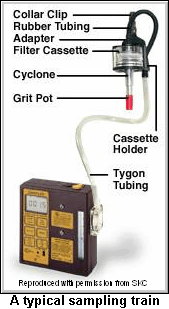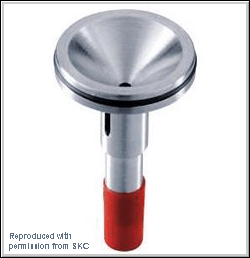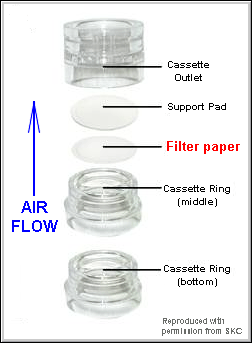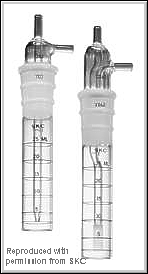 |
| Module 1: Occupational Hygiene - Section 3: Evaluation of Airborne Contaminants |
| OH3.3: Sampling Equipment |
 |
| Module 1: Occupational Hygiene - Section 3: Evaluation of Airborne Contaminants |
| OH3.3: Sampling Equipment |
SAMPLING EQUIPMENT:There are many different methods of taking air samples, but by far the most widely used is the sampling train method*. It consists of a battery-operated personnel sampling pump, a connecting tube, and a sampling medium. The pump should be capable of drawing air through the medium at a constant rate for at least 8 hours. |
 |
Passive monitoring:
These are devices that allow air sampling without the use of pumps to transfer contaminant to the surface of the collector. They rely on diffusion or permeation of gases and vapours in air. The rate at which the contaminant diffuses into the tube or badge is determined by the manufacturer. Analytes diffuse at a rate proportional to concentration of contaminant.
Monitoring begins when the device's cover is removed and when sampling is complete the monitor is sealed. Diffusion samplers are not gas tight. Some of the sample may be lost if sampling duration is too long.
The rate at which contaminant is transferred depends depends on the concentration gradient from air to collector. Sampling rate is influenced by ambient wind velocity and temperature.
Passive samplers are easy to use and are relatively inexpensive.
Sampling media:
Airborne chemical substances are measured using an air sampling pump which passes air, at a pre-determined rate, through a medium which traps the contaminants. The "trap" is either a charcoal tube, a filter paper or a container, filled with distilled water or a chemical reagent.
 |
A cyclone is a device which separates larger from smaller particles. As the air is drawn through the cyclone, it is given a circular motion. Centrifugal forces cause the heavier particles to settle on the periphery, from which they are collected in a separate container. The lighter particles are then collected on the filter. |
| The filter paper can be analysed chemically or can be weighed to determine the amount of contaminant deposited. For gravimetric analysis the filter is weighed before and after sampling and the difference is the amount of contaminant collected. The filter can be dissolved in a special reagent and a specialised method is used to find out how much of the contaminant is dissolved in the solution. Filter paper is used to sample air for dust, fumes and mist. |  |
 |
Air is bubbled through a chemical solution contained in a glass impinger or bubbler for a predetermined period. The contaminant contained in air reacts with the solution resulting in either a colour change or the precipitation of a solid substance which is deposited in the tube. The intensity of the colour change or the amount of precipitation gives an indication of the amount of contaminant that is present in the workplace atmosphere. This method of sample collection is ideal for reactive gases and vapours. |
Flow Rate:
Pumps are selected based upon the desired flow rate, ease of servicing and calibration, size, cost and suitability for hazardous environments. The primary selection criterion is the flow rate. Low flow pumps (0.5 to 500 ml per minute) are used for sampling gases and vapours; high flow pumps (0.5 to 4 l per minute) are used for sampling particulates and bioaerosols.
*Permission to use obtained from SKC
